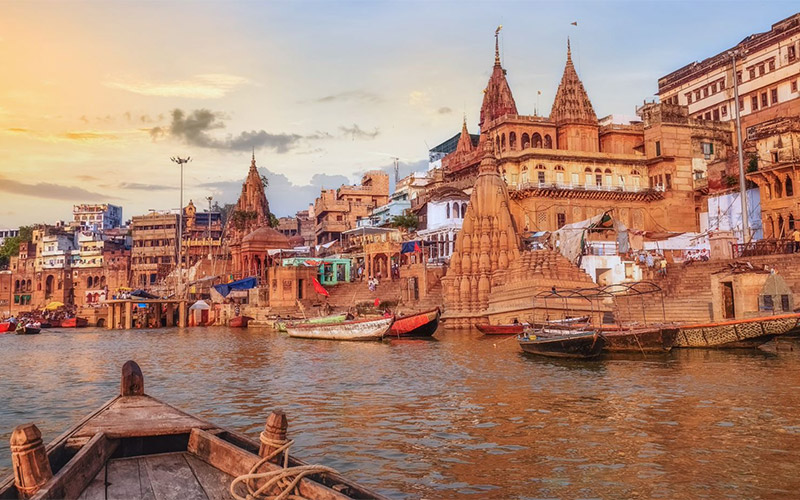Varanasi, also known as Banaras, is one of the oldest and holiest cities in India. Nestled on the banks of the Ganges River, it is a place of profound spiritual significance for Hindus. The Ghats in Varanasi form a mesmerizing array of steps leading down to the holy river, where ancient rituals and ceremonies are performed daily. In this comprehensive guide, we will delve into the heart of Varanasi's Ghats, revealing their history, rituals, and the unique experiences they offer.
Ghats in Varanasi: A Glimpse into Spirituality
The Ghats in Varanasi are a testament to the city's rich cultural and religious heritage. Lined up in a chronological sequence along the Ganges River, each Ghat has its unique story and significance.
Let's explore some of the most prominent Ghats in Varanasi:
Assi Ghat: Where Sacred Waters Merge
At the southernmost end of the Ghats lies Assi Ghat, believed to be the spot where the sacred Assi River meets the Ganges. It is a popular destination for pilgrims and tourists alike, known for its vibrant evening Aarti (ceremony) that illuminates the river with the light of a thousand oil lamps.
Dashashwamedh Ghat: Awe-Inspiring Evening Aarti
Dashashwamedh Ghat, the main Ghat of Varanasi, is renowned for its grand evening Aarti that takes place at sunset. The Aarti is a captivating spectacle of rhythmic chanting, incense, and the rhythmic movements of the priests, drawing a multitude of devotees and visitors every day.
Manikarnika Ghat: Gateway to Liberation
Manikarnika Ghat is the most sacred cremation ground in Varanasi. According to Hindu beliefs, cremation here leads to Moksha, liberation from the cycle of birth and death. While it may seem morbid to some, the ritualistic cremations are an integral part of the spiritual fabric of Varanasi.
Harishchandra Ghat: A Symbol of Truth
Named after the legendary King Harishchandra, who was known for his unwavering truthfulness, Harishchandra Ghat is another cremation site. Witnessing the last rites here reminds visitors of the impermanence of life and the ultimate truth of death.
Man Mandir Ghat: Architectural Marvel
Built by Maharaja Man Singh of Amber, Man Mandir Ghat is an architectural gem. Its stunning palace displays exquisite Rajput architecture and offers a breathtaking view of the Ganges River.
Scindia Ghat: Classical Music Delight
Scindia Ghat is known for its association with classical music and performing arts. Several music festivals and cultural events are organized here, showcasing India's rich artistic heritage.
Darbhanga Ghat: Splendid Palace and Temple
Darbhanga Ghat boasts a magnificent palace that reflects the opulence of Bihar's Darbhanga royal family. The adjacent temple dedicated to Lord Shiva adds to the spiritual aura of this Ghat.
Chet Singh Ghat: A Tale of Bravery
Chet Singh Ghat commemorates the valiant Chet Singh, who fought against the British East India Company during the 18th century. Visiting this Ghat offers a glimpse into Varanasi's historical past.
The Unique Experiences of Varanasi's Ghats
Varanasi's Ghats offer more than just spiritual significance. They present a plethora of unique experiences that enchant visitors from all walks of life.
Let's uncover some of these unforgettable encounters:
Boat Ride at Sunrise: Embrace Serenity
One of the most serene experiences in Varanasi is a boat ride along the Ganges during the early hours of the day. As the sun rises, the river comes to life with the chanting of mantras and the sight of people performing their morning rituals.
Ganga Aarti: Witness the Divine Ritual
Attending the Ganga Aarti at Dashashwamedh Ghat is a soul-stirring experience. The atmosphere is electric with devotion as the priests perform the ritual, accompanied by the melodious sounds of bells and conch shells.
Photography Expedition: Capture Timeless Moments
For photography enthusiasts, the Ghats in Varanasi are a treasure trove of captivating shots. From candid portraits of Sadhus (holy men) to the vibrant colors of the Aarti, each frame captures the essence of spiritual life in Varanasi.
Yoga and Meditation: Attain Inner Peace
Many Ghats in Varanasi offer yoga and meditation sessions to promote physical and mental well-being. Practicing yoga on the banks of the Ganges, with the gentle flow of the river as background music, is an enriching experience.
Street Food Exploration: Delight Your Palate
Varanasi's Ghats are a culinary paradise, offering a wide array of delectable street food. Savor the flavors of chaats, sweets, and traditional dishes while taking in the charming ambiance of the city.
Evening Ganga Aarti Boat Ride: A Magical Evening
Experiencing the Ganga Aarti from a boat on the Ganges is an ethereal encounter. The shimmering reflections of the lamps on the river create a magical atmosphere, leaving a lasting impression on every soul.
Frequently Asked Questions
What is the best time to visit the Ghats in Varanasi?
The best time to visit the Ghats in Varanasi is during the winter months (October to February) when the weather is pleasant and the river remains calm. Avoid the monsoon season as the Ganges tends to swell, making boat rides unsafe.
